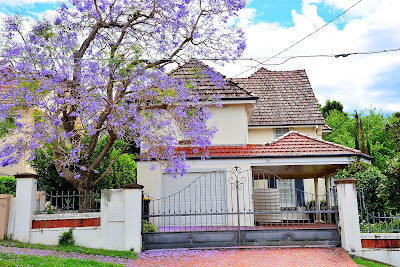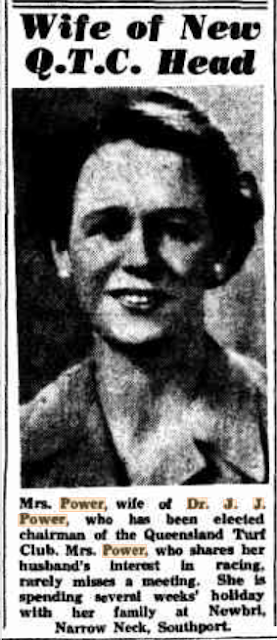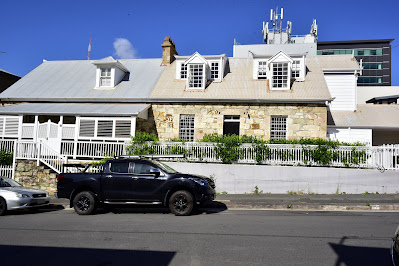You may pass this building on your travels and not realise that this structure dates back to 1865 and was one of the early grand villas of Brisbane. Toonarbin was once the only home in this part of the town. With grounds stretching down to the Brisbane River and up to the crown of Highgate Hill it truly was a grand villa. While what you see on the outside today is definitely what one would have seen in 1865 it is still a wonderful part of out early home history.
Toonarbin shares an amazing link to another of the early homesteads of Brisbane but this time on the northern side of the river. This concise reference from Must Do Brisbane gives a very succint summary.
"Having built his house Montpelier on a hill he named after himself -‘O’Reilly’s Hill’ (later Bowen Hills) - early settler and ASN shipping firm man Captain O’Reilly moved across the river and acquired another hilly bushland site from architect Benjamin Backhouse.
Here he built this imposing yet austere multichimneyed two storey mansion ‘Toonarbin’, which at the time looked at odds with its secluded bushy site. In 1926 it was purchased by the religious real estate king of Brisbane, Archbishop Duhig, as part of his ever growing Catholic empire and converted to a convent for the Sisters of Mercy. It operated as a convent until 1995 and some years later was bought by a private owner who meticulously restored it to its past glory."
For a more in depth history about Toonarbin and the Highgate Hill area the web site Highgate Hill and Its Stories is essential and wonderful reading. Very well researched and written it does give an indepth insight into the area.
https://highgatehill-historical-vignettes.com/2018/08/05/toonarbin/
After a successful career as a ship's captain Captain O'Reilly became the Brisbane manager of the Australasian Steam Navigation Comapny (ASN). The offices of ASN were where what we now know as Naldham House situated at the corner of Felix and Mary Streets in Brisbane.
Brisbane Courier (Qld. : 1864 - 1933), Monday 19 February 1877, page 3
Death of Captain O'Reilly.
Although the event has for some weeks, if not months, been expected, a very large number of our readers will learn with sincere regret of the death of Captain Henry O'Reilly, which took place yesterday afternoon, at his residence, Hill End, South Brisbane. Several years ago the deceased gentleman became troubled with a painful disease in one of his eyes, the sight of which became greatly affected, and in 1866 he visited England for the purpose of having an opera-tion performed on the affected organ. This was done, but no permanent benefit resulted therefrom. Ultimately cancer formed on the face near the eye, and for this disease he underwent another operation about ten months ago, which un-fortunately was too late to check the spread of the disease. Since then the state of his health grew rapidly worse. He was obliged to retire from his business avocations, and some months ago it was known to the deceased gentleman himself, and amongst his personal friends, that there was no room for hope of his recovery. During the last few days it became evident that the hour of merciful release from his long and painful illness was rapidly approaching. Yester-day forenoon he was conscious for a little while, and was able to speak with those around him, but it was only the brief revival which so fre-quently precedes the great final change, and he expired shortly before four o'clock in the afternoon.
Captain O'Reilly, who was a native of Dublin, was for some time in the service of the Dublin Steam Packet Company, and also served as chief officer in the fleet of the St. George Steam Packet Company, amongst whose customers he was exceedingly popular. About 1853 he came out to Sydney, and the same year took service with the A.S.N. Co. as captain of the steamer City of Melbourne. Subsequently he commanded the Boomerang, and left her to take charge of the Telegraph. He was engaged almost exclusively in the Queensland trade until 1864, when he relinquished command of the Telegraph to take charge of the Brisbane Agency of the Company. In that capacity he acted till compelled by illness, a few months ago, to abstain from business. Captain O'Reilly was one of the oldest, if not the oldest servant of the A.S.N. Co. and certainly the Company had none more devoted to its interests, with which he most thoroughly and actively identified himself. The Company has, at various times, been very unpopular in this colony, but that unpopularity never extended to its principal representative. His courtesy to the public never varied, whether as captain of the Company's boats, or as the medium between his employers and the mercantile community of Brisbane, and his sound judgment and tact has, we make no doubt, often prevented the discontent of the Queensland public with the Company's treatment of the trade of this colony taking a definite shape which might have been far from satisfactory to the great Sydney corporation.
Captain O'Reilly was in his 53rd year. His funeral will leave his residence at four o'clock this afternoon.
Brisbane Courier (Qld. : 1864 - 1933), Monday 19 February 1877, page 1
Telegraph (Brisbane, Qld. : 1872 - 1947), Tuesday 7 April 1925, page 10
Late Mr. Charles O'Reilly
LARGELY ATTENDED FUNERAL
The death of Mr.Charles John O Reilly removes a well known iden tity, from the commercial life of Bris bane. For many years he conducted a bonded warehouse customs agency, and general carriers busincssin Mar garet Street. The firm was established in 1860. and was the oldest established of the kind In Brisbane. The deceased gentleman was born at Balmain. Syd ney, in 185o. He was a son of the late Captain Henry O'Reilly, one of the earliest agents in Brisbane for the old A.S.N. Co., In his early days Mr. O'Reilly lived with his parents at their home, Montpelier on O'Reillys Hill. This was sold and the family moved to a cottage an the site where the A.U.S.N. buildings now stand. He at tended the Ipswich - Grammar School, and later the High School, Hobart. Mr. O'Reilly started his business career with Gibbs. Bright, and Co., and after was with the A.S.N. Co., which, subsequently merged into tho A.U.S.N. Co. On the recommendation of Mr. Dawes (of Grey, Dawes, and Co.) certain activities were relinquished by the company, which the late Captain Henry O'Reilly took over as a separate business. On the death of Captain O'Reilly, Mr. Charles O'Reilly assumed control at the age of 24. Property was bought in Margaret street, and the bonded and free stores were built. It was largely through the efforts of his arm the Master Carriers-Association was formed in Brisbane. He was elected the first president. Mr. O'Reilly was survived by his widow his sister , (Mrs. G. G. Miller), two sons (Messrs. Harry and Bernard O'Reilly) and a daughter (Mrs. Douglas Henderson, of Mel bourne). Another daughter (Mrs. Charles H. Paterson, of Brisbane) died some time ago. The funeral was held yesterday afternoon, and was largely attended. The cortege moved from tlio deceased gentleman's late residence. Toonarbin, Dornoch terrace, South Brisbane, to the South Brisbane cemetery. The service was conducted by Rev. A. E. Smith, of the Church of England, Coorparoo.
Brisbane Courier (Qld. : 1864 - 1933), Saturday 31 March 1928, page 28
Brisbane Courier (Qld. : 1864 - 1933), Wednesday 24 March 1926, page 8
NEW CATHOLIC SCHOOLS.
HISTORIC HOMES PURCHASED.
Two properties-Toonarbin, Dornoch terrace, the home of the late Mr Charles O'Reilly, and Warranoake, Mr Gilson Foxton s residence, at Indooroopilly - have been purchased by Dr Duhig (Archbishop of Brisbane), and will be used for the establishment of schools. The houses stand in about 8 and 4 acres of land respectively. Toonarbin, which is a three-story stone structure, was for a long time one of the well-known landmarks ot Brisbane while Warranoake was built some 40 years ago by Mr. Foxton, who was for some years police magistrate at Thursday Island.
Brisbane Courier (Qld. : 1864 - 1933), Saturday 31 March 1928, page 20
The new convent at Dornoch-Terrace, West End, which will be opened by Dr. Duhig (Archbishop of
Brisbane) to-morrow afternoon.
Queenslander (Brisbane, Qld. : 1866 - 1939), Thursday 3 September 1931, page 24














































